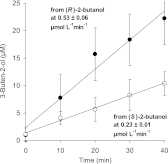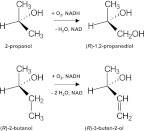Synthesis of short-chain diols and unsaturated alcohols from secondary alcohol substrates by the Rieske nonheme mononuclear iron oxygenase MdpJ
- PMID: 22752178
- PMCID: PMC3416598
- DOI: 10.1128/AEM.01434-12
Synthesis of short-chain diols and unsaturated alcohols from secondary alcohol substrates by the Rieske nonheme mononuclear iron oxygenase MdpJ
Abstract
The Rieske nonheme mononuclear iron oxygenase MdpJ of the fuel oxygenate-degrading bacterial strain Aquincola tertiaricarbonis L108 has been described to attack short-chain tertiary alcohols via hydroxylation and desaturation reactions. Here, we demonstrate that also short-chain secondary alcohols can be transformed by MdpJ. Wild-type cells of strain L108 converted 2-propanol and 2-butanol to 1,2-propanediol and 3-buten-2-ol, respectively, whereas an mdpJ knockout mutant did not show such activity. In addition, wild-type cells converted 3-methyl-2-butanol and 3-pentanol to the corresponding desaturation products 3-methyl-3-buten-2-ol and 1-penten-3-ol, respectively. The enzymatic hydroxylation of 2-propanol resulted in an enantiomeric excess of about 70% for the (R)-enantiomer, indicating that this reaction was favored. Likewise, desaturation of (R)-2-butanol to 3-buten-2-ol was about 2.3-fold faster than conversion of the (S)-enantiomer. The biotechnological potential of MdpJ for the synthesis of enantiopure short-chain alcohols and diols as building block chemicals is discussed.
Figures





Similar articles
-
Bacterial degradation of tert-amyl alcohol proceeds via hemiterpene 2-methyl-3-buten-2-ol by employing the tertiary alcohol desaturase function of the Rieske nonheme mononuclear iron oxygenase MdpJ.J Bacteriol. 2012 Mar;194(5):972-81. doi: 10.1128/JB.06384-11. Epub 2011 Dec 22. J Bacteriol. 2012. PMID: 22194447 Free PMC article.
-
Formation of alkenes via degradation of tert-alkyl ethers and alcohols by Aquincola tertiaricarbonis L108 and Methylibium spp.Appl Environ Microbiol. 2011 Sep;77(17):5981-7. doi: 10.1128/AEM.00093-11. Epub 2011 Jul 8. Appl Environ Microbiol. 2011. PMID: 21742915 Free PMC article.
-
Engineering Rieske Non-Heme Iron Oxygenases for the Asymmetric Dihydroxylation of Alkenes.Angew Chem Int Ed Engl. 2015 Oct 26;54(44):12952-6. doi: 10.1002/anie.201506527. Epub 2015 Sep 9. Angew Chem Int Ed Engl. 2015. PMID: 26351244
-
Rieske non-heme iron-dependent oxygenases catalyse diverse reactions in natural product biosynthesis.Nat Prod Rep. 2018 Jul 18;35(7):622-632. doi: 10.1039/c8np00004b. Nat Prod Rep. 2018. PMID: 29651484 Review.
-
Rieske business: structure-function of Rieske non-heme oxygenases.Biochem Biophys Res Commun. 2005 Dec 9;338(1):175-90. doi: 10.1016/j.bbrc.2005.08.222. Epub 2005 Sep 8. Biochem Biophys Res Commun. 2005. PMID: 16168954 Review.
Cited by
-
Thermophilic bacteria are potential sources of novel Rieske non-heme iron oxygenases.AMB Express. 2017 Dec;7(1):17. doi: 10.1186/s13568-016-0318-5. Epub 2017 Jan 4. AMB Express. 2017. PMID: 28050858 Free PMC article.
-
Actinobacterial Degradation of 2-Hydroxyisobutyric Acid Proceeds via Acetone and Formyl-CoA by Employing a Thiamine-Dependent Lyase Reaction.Front Microbiol. 2020 Apr 15;11:691. doi: 10.3389/fmicb.2020.00691. eCollection 2020. Front Microbiol. 2020. PMID: 32351493 Free PMC article.
-
Contrasting Mechanisms of Aromatic and Aryl-Methyl Substituent Hydroxylation by the Rieske Monooxygenase Salicylate 5-Hydroxylase.Biochemistry. 2023 Jan 17;62(2):507-523. doi: 10.1021/acs.biochem.2c00610. Epub 2022 Dec 30. Biochemistry. 2023. PMID: 36583545 Free PMC article.
-
Constitutive expression of the cytochrome P450 EthABCD monooxygenase system enables degradation of synthetic dialkyl ethers in Aquincola tertiaricarbonis L108.Appl Environ Microbiol. 2013 Apr;79(7):2321-7. doi: 10.1128/AEM.03348-12. Epub 2013 Jan 25. Appl Environ Microbiol. 2013. PMID: 23354715 Free PMC article.
References
-
- Aslett D, Haas J, Hyman M. 2011. Identification of tertiary butyl alcohol (TBA)-utilizing organisms in BioGAC reactors using 13C-DNA stable isotope probing. Biodegradation 22: 961–972 - PubMed
-
- Balmer E, Germain A, Jackson WP, Lygo B. 1993. Larger scale preparation of optically-active allylic alcohols. J. Chem. Soc. Perkin Trans. 1: 399–400
-
- Bastida F, et al. 2010. Elucidating MTBE degradation in a mixed consortium using a multidisciplinary approach. FEMS Microbiol. Ecol. 73: 370–384 - PubMed
-
- Batie C, La Haie JE, Ballou DP. 1987. Purification and characterization of phthalate oxygenase and phthalate oxygenase reductase from Pseudomonas cepacia. J. Biol. Chem. 262: 1510–1518 - PubMed
Publication types
MeSH terms
Substances
LinkOut - more resources
Full Text Sources
Other Literature Sources

